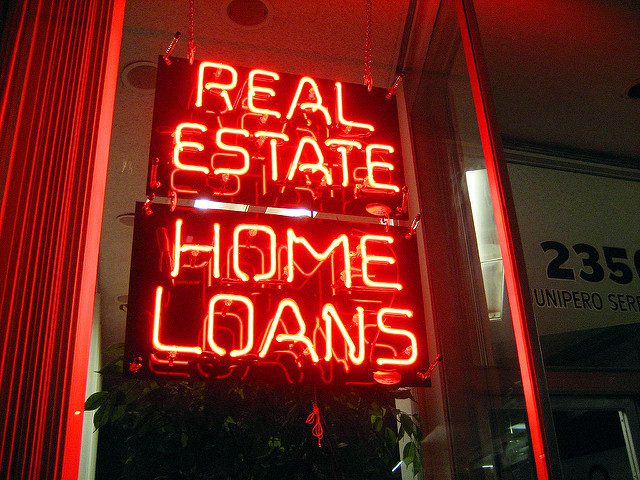
Photo by Todd Lappin, via flickr, CC BY-NC 2.0.
Editor’s Note: In “Long Before Redlining: Racial Disparities in Homeownership Need Intentional Policies,” Lisa Rice delved into how early racially based discriminatory practices in the U.S. built the foundation of white wealth that has led us to our modern-day wealth disparity.
By the 1990s, after 100 years of government- and private-based discriminatory practices, the subprime lending market was burgeoning as it preyed on communities of color. In communities across the country, predatory lenders were providing the majority of purchase and refinance loans to consumers of color. As these loans grew more toxic, foreclosure rates in communities of color were increasing precipitously. These consumers were the canaries in the coal mine.
African-American and Latinx homeowners experienced foreclosures at rates 2.5 and 2 times greater than white homeowners. While whites have seen real recovery in the aftermath of the foreclosure crisis, in many cases communities of color have not. In fact, the African-American homeownership rate, at about 42 percent, is where it was 50 years ago when the Fair Housing Act was passed. The homeownership gap between whites and African Americans is at its greatest divide since 1900 when the gap was 27.6 percentage points. Today the gap is 30.3 percentage points.
According to the Urban Institute, white households have 10 times the wealth of Latinx households and 12 times the wealth of African Americans. The Economic Policy Institute reports that African Americans with a graduate or professional degree have $200,000 less wealth than their white counterparts. In another analysis by the Urban Institute, consumers of color are disproportionately experiencing a decline in mortgage loan originations in the aftermath of the foreclosure crisis.
Among other outcomes, this disparity has led to a dual credit market in which consumers with little access to traditional financial products are relegated to non-traditional lenders, setting off a downward spiral that makes them more likely to be credit invisible or have lower credit scores. Almost 30 percent of African-American and Latinx consumers are credit invisible or unscoreable. And while conventional wisdom asserts that technology-based mechanisms like credit scoring and automated underwriting systems remove unfair bias and discrimination, they actually make the manifestation of racial biases and inequality easier.
Credit scoring and automated underwriting systems rely on algorithms that are actually weaponized against communities of color, utilizing data that are infused with and reflect the discrimination that is replete throughout our financial and housing markets.
A Shifted Mode of Discrimination
Researchers at Berkeley have found that FinTech lenders who rely on algorithms to generate decisions on loan pricing discriminate against borrowers of color because their systems simply reflect the bias they pick up in the marketplace. The Berkeley researchers estimate that borrowers of color are being overcharged by $250 million to $500 million annually in the FinTech space alone. In essence, “algorithms have not removed discrimination, but may have shifted the mode.” Variables, the pieces of information that go into the algorithms upon which these systems are built, do not exist in isolation. Each piece of information carries with it other bits of data, including data that inherently connects risk to race. Take a person’s address for example. That one piece of data—an address—can carry with it multiple other data points like life expectancy, credit score, net worth, educational attainment, and income.
Scoring mechanisms reflect systemic racism in other ways as well. Communities of color have a dearth of mainstream financial institutions and a plethora of nontraditional lenders. The former reports positive payment information to credit agencies; the latter typically does not. This means that consumers, disproportionately people of color, who are accessing non-traditional credit sources will have artificially lower credit scores because these systems do not capture positive information from alternative credit providers like payday lenders and check cashers.
Additionally, numerous studies highlight the discrimination that borrowers of color face when they try to access credit. These borrowers, when denied the credit they deserve or are quoted higher interest rates, are compelled to visit multiple lenders to try and obtain credit or get a fairer rate; but the more inquiries a consumer has on their credit report, the lower their credit score. Credit scoring algorithms don’t compensate for the increased discrimination borrowers of color experience in the marketplace, rather scoring algorithms punish borrowers who experience discrimination by artificially lowering their scores.
The effects of historical and current discriminatory policies and systems, particularly those supported by the federal government, still drive the racial disparities we see today in homeownership rates, wealth attainment, student debt accumulation, educational and health outcomes, credit access, and more. Policies and laws like Urban Renewal, Model Cities, the Chinese Exclusion Act, and the Federal-Aid Highway Act destroyed businesses, eviscerated the wealth of people of color, compounded the effects of disinvestment in communities of color, and trapped people in neighborhoods where their property values could not appreciate.
Americans generally, and white Americans in particular, are not aware of the huge economic benefits white Americans have received over centuries. The notion that people amassed generational wealth solely by hard effort is misleading at best. Without broad-scale government and taxpayer support, these families would not have been able to realize the achievement of land and homeownership.
The existence of federal programs that supported wealth accumulation seems normal, but the fact that Americans of color did not have the same access appears to be lost on elected representatives, government officials, corporate leaders, and the general populace. Instead of acknowledging that race-based policies created and perpetuated the inequities we see today, we pretend that the differences in opportunities people have stem from a difference in effort.
Overhauling a Fundamentally Unfair System
We have been purposeful about creating structural inequality, and we must be intentional about undoing the structure—not just finding new ways to attempt to be “fair” moving forward. The reality is that until we overhaul our systems, there is no way to provide opportunities to people on a fair and equitable basis. Small, poorly funded programs designed to benefit everyone simply won’t cut it. America—via government, business, and people—engineered inequality, and so it will take the concerted effort of all these players to dismantle and overhaul fundamentally unfair systems to create opportunities that will purposefully accelerate economic achievements for people of color.
Providing educational benefits and homeownership opportunities for the descendants of enslaved Africans, creating banking products designed to transport people from the fringe credit market into the financial mainstream, and developing credit scoring systems that compensate for the discrimination inherent in our markets are all examples of the kinds of policies and programs we need to implement.
Prosperity Now projects that holding white wealth constant, it will take African Americans 228 years and Latinxs 84 years to reach parity with their white counterparts. Since we know white wealth will not remain static, Prosperity Now’s analysis underscores the reality that without intentional change, the racial wealth gap will continue to grow. We have the resources to effectuate a fair and equitable system; what we need is the determination to bring it about and a government willing to provide equal support to its citizens of color.
To learn more about how housing discrimination and redlining still impact us today, read Richard Rothstein’s The Color Of Law and Gregory Squires’ The Fight for Fair Housing.






Comments